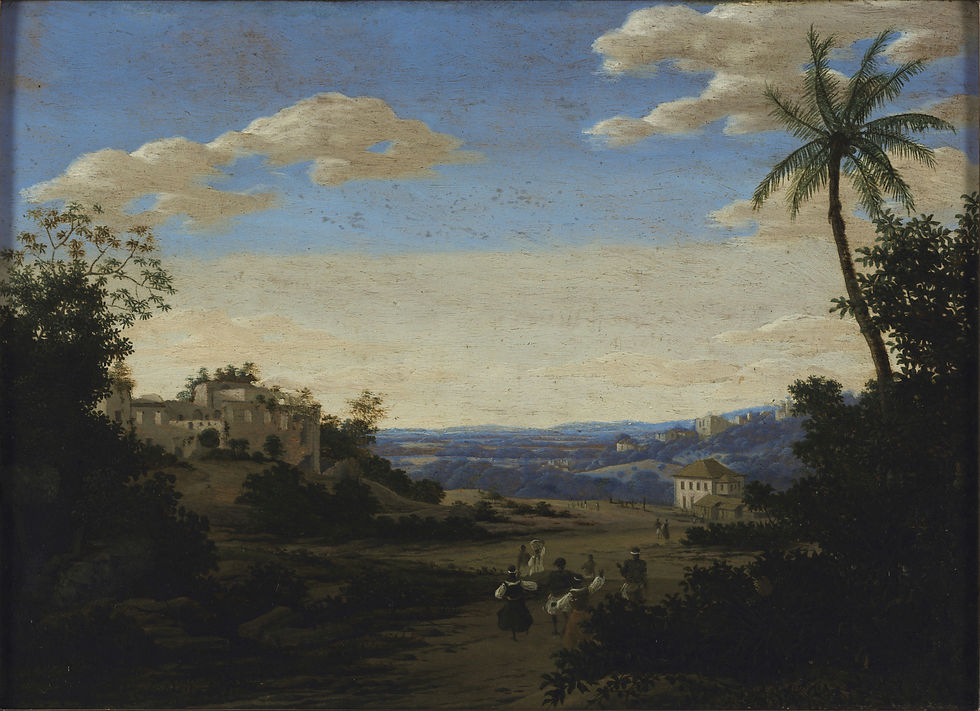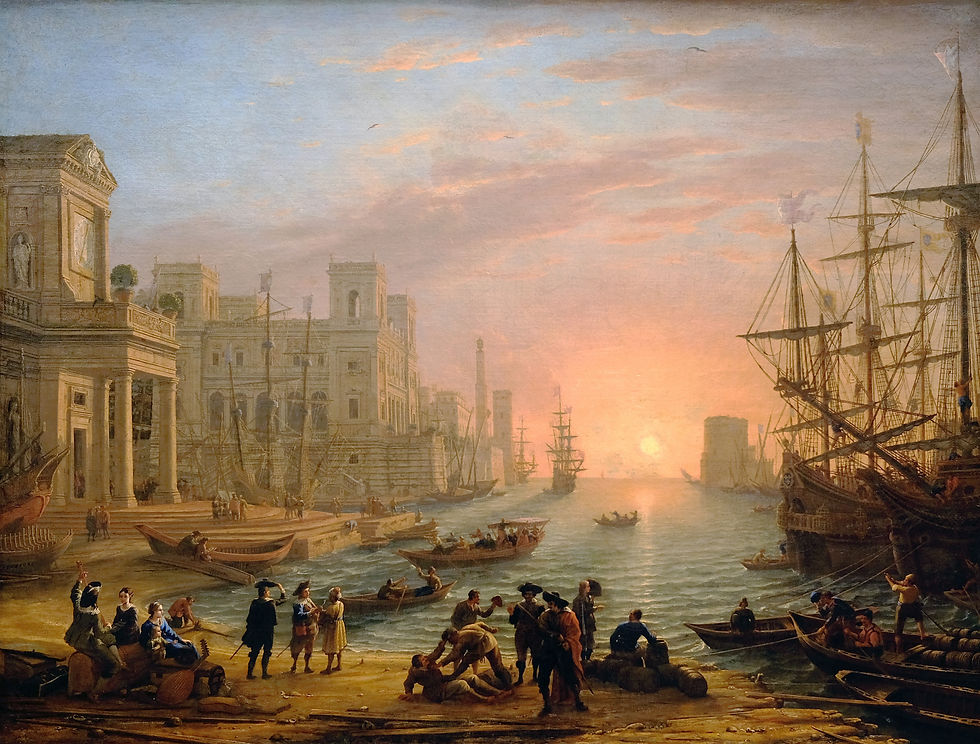Landscape Artists You Should Know About...Part II
- Ahmed Kheder

- Nov 18, 2023
- 5 min read
Updated: Jan 20, 2024
Throughout history, landscape artists reflected the cultural overlay of human presence, the character involved by the artist in a landscape painting helps define the self-image of the people who inhabit the landscape and a sense of place that differentiates one region from other regions. A landscape painting simply is a visual documentary backdrop to people's lives.
In This Article we shall discuss the biography of the landscape painting pioneers:
The first European artist to paint landscapes of the Americas... Frans Janszoon Post.
In 1636, Frans Janszoon Post (17 November 1612 – 17 February 1680) traveled to Dutch Brazil in northeast of South America at the invitation of the governor Johan Maurits van Nassau-Siegen.
The Dutch Golden Age painter Frans Janszoon Post, though he was not registered in the guild until after his return, was the first European artist to paint landscapes of the Americas, during and after the period of Dutch Brazil.

At the time, Haarlem experienced an outbreak of the plague, so that his going to Brazil may have seemed a good option.
While Post was in charge of documenting the land, Albert Eckhout, another one of Nassau’s artists, was in charge of documenting the native people.
Post lived in Brazil from 1637 to 1644. He received 800 guilders for a landscape painting in the West Indies commissioned by Frederick Henry, Prince of Orange.
These works depict specific locations in Dutch Brazil, identifiable because of the representation of recognizable topography and buildings. Post includes a selection of Brazilian vegetation, and occasionally features birds and other small animals in the foreground.
Post continued to paint images of Brazil upon his return to The Netherlands in 1642, those paintings executed in The Netherlands have brighter colors with dark foliage framing an idealized baroque composition.

Frans Post's landscapes are open, full of resources. They evolve to show a more condensed view and desired depth with greener flora, bluer skies, and brighter horizons.
Upon Post’s return to The Netherlands, nearly every painting he completed in The Netherlands includes a large group of people interacting in some way, whether they are dancing or working in the sugar mills, typically, these figures are slaves. Unlike his Brazilian work, the figures are no longer subjects placed in the foreground; instead, they seem to become part of the landscape.
Post produced approximately 140 paintings during his lifetime. Of these, nearly half are dated, making it possible to track the evolution of his work between 1637, the day he landed in Brazil, and 1669, the date of his last letter. Frans Post continued to paint Brazilian scenes until 1669, and the lack of dated paintings in the 1670s suggests he stopped ten years before his death.
Frans Post's Brazilian landscape paintings strongly resemble the landscapes by his Haarlem contemporaries in terms of composition, style, and technique.
Frans Post's works were widely collected in The Netherlands, Europe, and Brazil, with the works showing an idealized vision of Dutch colonial rule.
So little is known of the last decade of post's life, Whitehead and Boeseman claim that Post developed an alcohol problem, which may be the reason He died in Haarlem and was buried in the St. Bavochurch on February 17, 1680.
Claude Lorrain...One of the earliest artists to concentrate on landscape painting.
One of the earliest important artists, apart from his contemporaries in Dutch Golden Age painting, to concentrate on landscape painting. (1600 – 23 November 1682) The French painter of the Baroque era Claude Lorrain.
Who Is Claude Lorrain
Claude Lorrain was not generally an innovator in landscape painting, except in introducing the sun and streaming sunlight into many paintings, which had been rare before.

Claude Lorrain was born in the small village of Chamagne, Vosges, then part of the Duchy of Lorraine. He was the third of five sons of Jean Gellée and Anne Padose.
Claude's parents both died when he was twelve years old, and he then lived at Freiburg with an elder brother (Jean Gellée). Jean was an artist in inlay and taught Claude the rudiments of drawing. Claude then travelled to Italy, first working for Goffredo Wals in Naples, then joining the workshop of Agostino Tassi in Rome.
While the details of Claude's pre-1620s life remain unclear, most modern scholars agree that he was apprenticed to Wals around 1620–1622, and to Tassi from circa 1622/23 to 1625.
By the end of the 1630s Claude Lorrain was established as the leading landscapist in Italy, His landscapes gradually became larger, but with fewer figures, more carefully painted, and produced at a lower rate.
Claude Lorrain spent most of his life in Italy, His landscapes are usually turned into history paintings by the addition of small figures typically representing a scene from classical mythology.
On his travels, Claude briefly stayed in Marseilles, Genoa, and Venice, and had the opportunity to study nature in France, Italy, and Bavaria.
In 1650, Claude moved to a neighboring house in Via Paolina (today Via del Babuino), where he lived until his death.
The artist never married, but adopted an orphan child, Agnese, in 1658; she may well have been Claude's own daughter with a servant of the same name.
The artist died in his house on 23 November 1682. He was originally buried in Trinita dei Monti, but his remains were moved in 1840 to San Luigi dei Francesi. At his death, he owned only four of his paintings, but most of his drawings.
Claude's tombstone gives 1600 as his year of birth, but contemporary sources indicate a later date, circa 1604 or 1605.
Claude Lorrain's Landscapes
Claude Lorrain was a prolific creator of drawings in pen and very often monochrome watercolor "wash", usually brown but sometimes grey. Chalk is sometimes used for under-drawing, and white highlighting in various media may be employed, much less often other colors such as pink.

Claude's Landscapes fall into three distinct groups:
Firstly, there are large numbers of sketches, mostly of landscapes, and apparently very often done at the scene; these have been greatly admired, and influenced other artists.
Then there are studies for paintings, of various degrees of finish, many clearly done before or during the process of painting, but others perhaps after that were complete.
This was certainly the case for the last group, the 195 drawings recording finished paintings collected in his Liber Veritatis (now in the British Museum).
Claude Lorrain produced over 40 etchings, often simplified versions of paintings, mainly before 1642. These served various purposes for him, but are now regarded as much less important than his drawings.
He painted frescoes in his early career, which played an important part in making his reputation, but are now nearly all lost.
In the late 1620s, it was reported that Claude had a habit of sketching outdoors, particularly at dawn and at dusk, making oil studies on the spot.
The first dated painting by Claude, Landscape with Cattle and Peasants (Philadelphia Museum of Art) from 1629, already shows well-developed style and technique.
In the next few years his reputation was growing steadily, as evidenced by commissions from the French ambassador in Rome (1633) and the King of Spain (1634–35).
Baldinucci reported that a particularly important commission came from Cardinal Bentivoglio, who was impressed by the two landscapes Claude painted for him, and recommended the artist to Pope Urban VIII. Four paintings were made for the Pope in 1635–1638, two large and two small on copper.
About 1636, Claude started cataloguing his works, making pen and wash drawings of nearly all his pictures as they were completed, although not always variant versions, and on the back of most drawings he wrote the name of the purchaser, not always sufficiently clearly to identify them now. This volume Claude named the Liber Veritatis (Book of Truth).
In 1663 Claude, who suffered much from gout, fell seriously ill, his condition becoming so serious that he drafted a will, but he managed to recover.
He painted less after 1670, but works completed after that date include important pictures such as Coast View with Perseus and the Origin of Coral (1674), painted for the celebrated collector Cardinal Camillo Massimo, and Ascanius Shooting the Stag of Sylvia.
Claude's last painting, commissioned by Prince Lorenzo Onofrio Colonna, his most important patron in his last years.



Comments